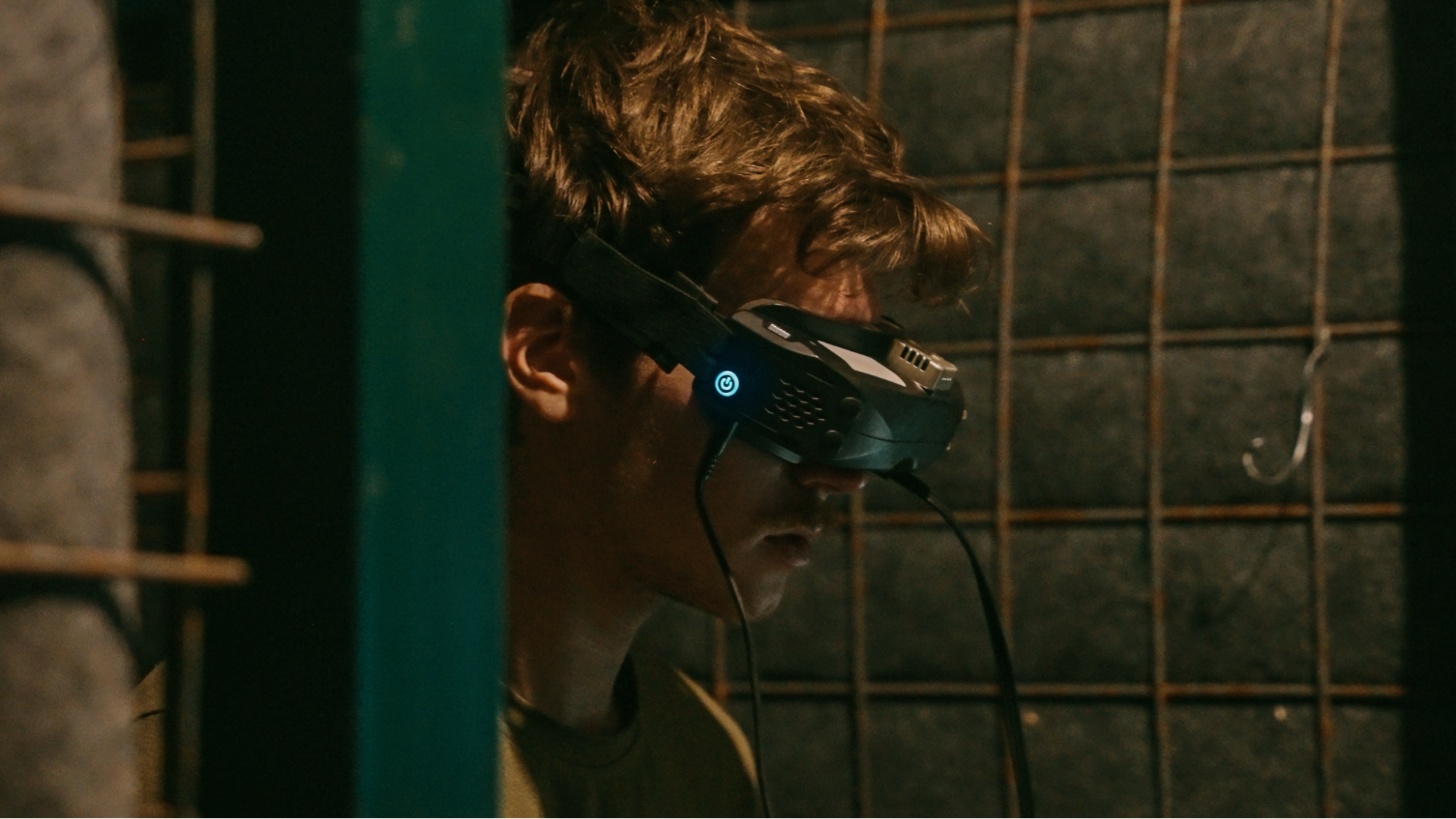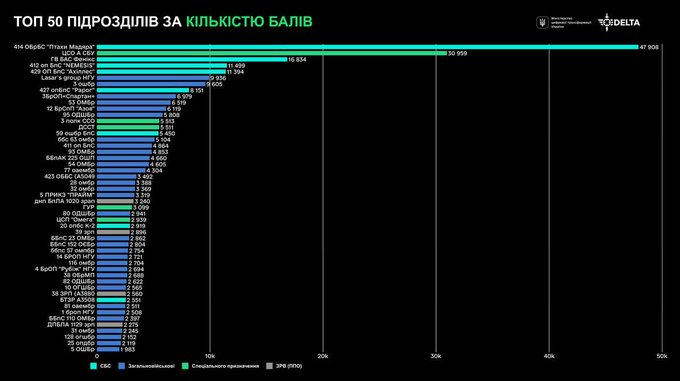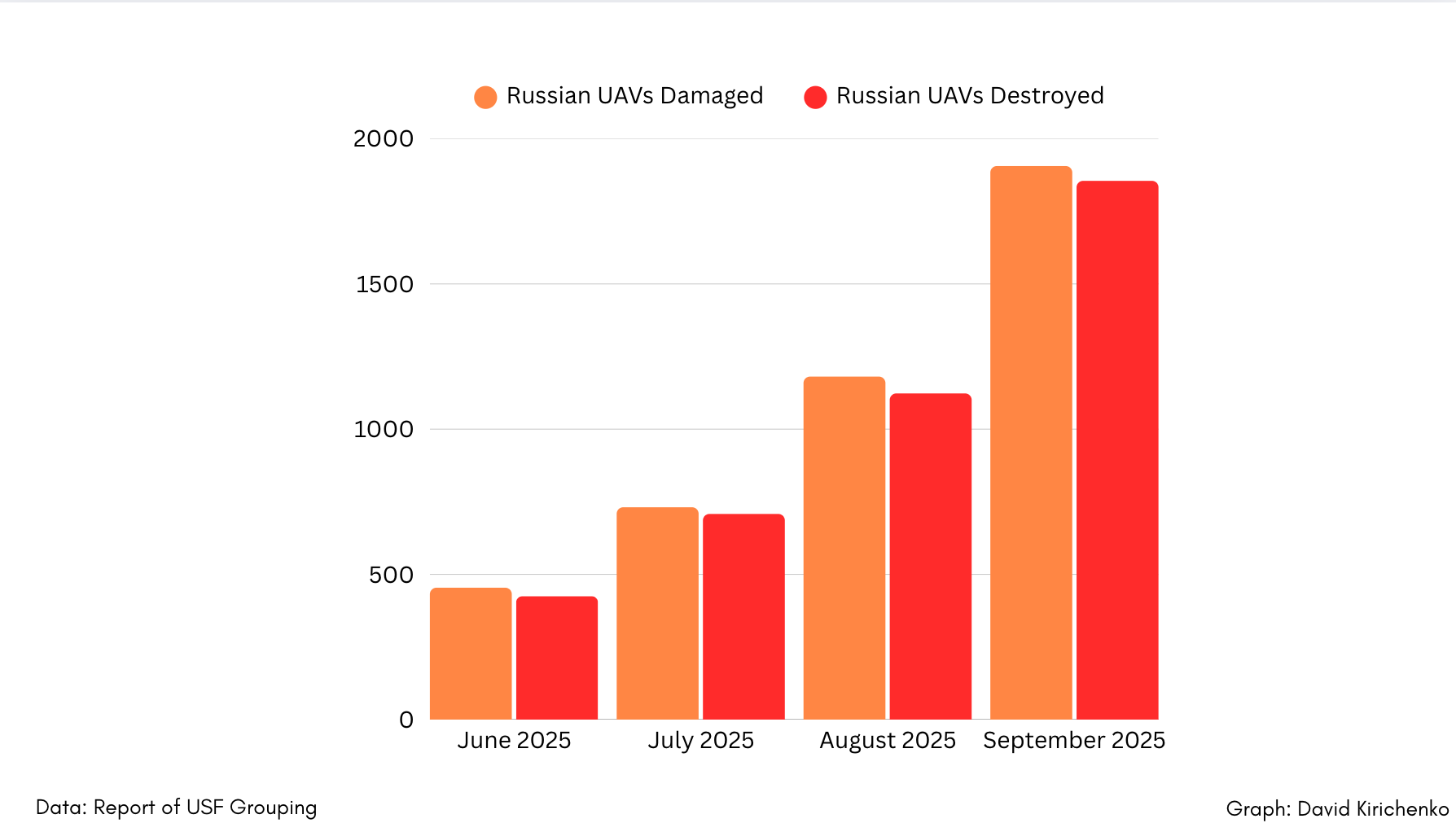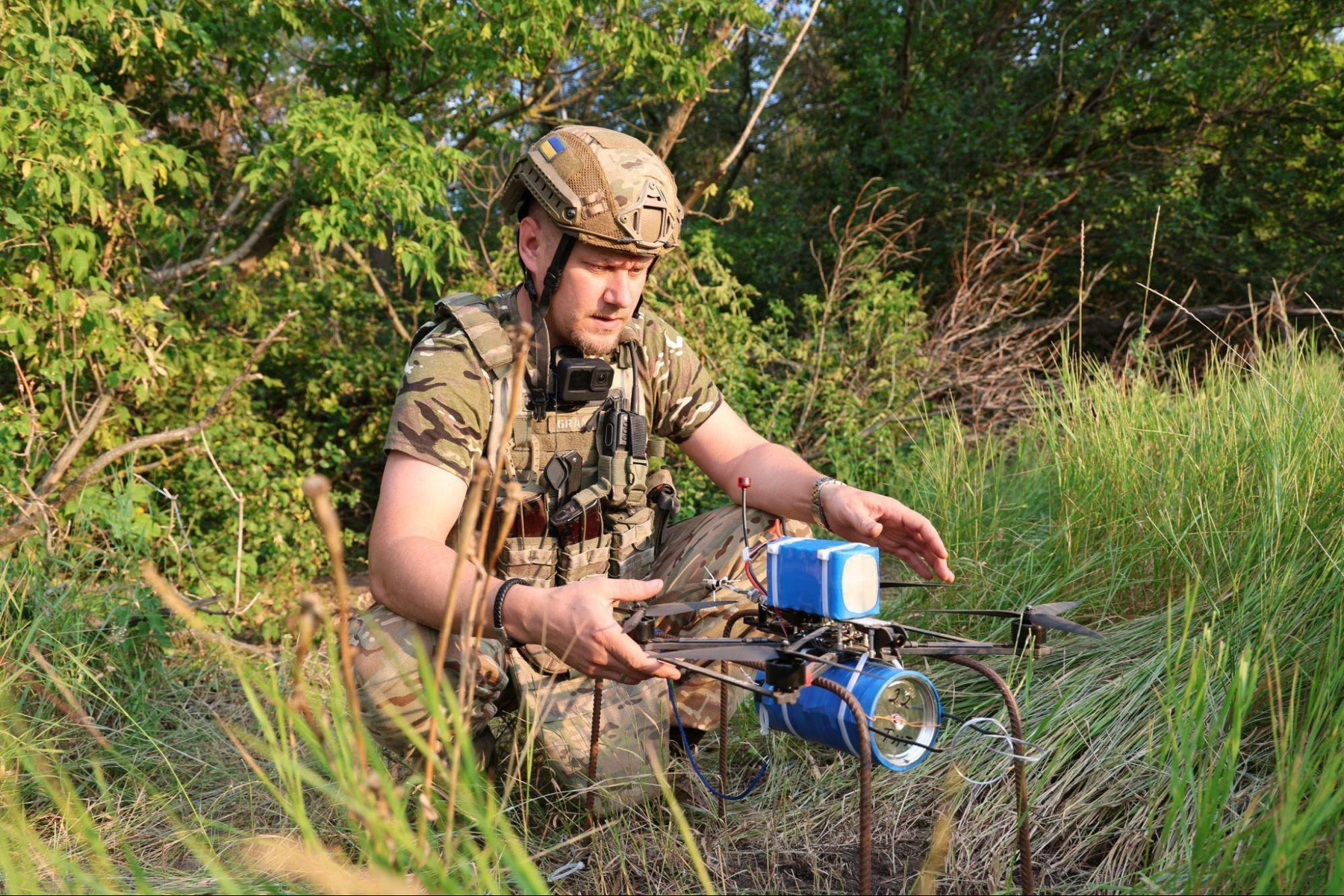Ukraine’s fight has been defined by ingenuity – the contributions of volunteers, the bravery of its soldiers, and the widespread use of technology. A key element has been the deployment of unmanned systems, particularly drones. These tools not only extend Ukraine’s reach on the battlefield but also generate vast amounts of data. Over the years, Kyiv has accumulated a trove of information that is now being systematically analyzed and applied. This data-driven approach is giving military leaders sharper insights, improving battlefield decisions, and reshaping how the war is being fought.
Bohdan, a drone pilot from the Unmanned Systems Battalion of Ukraine’s 110th Separate Mechanized Brigade, pilots a First-Person View (FPV) drone in Donetsk Oblast during active battle operations.

Photo: Ryan Van Ert
Among Ukraine’s military leadership, those with business backgrounds have often proven the most effective. They bring with them a culture of efficiency, data-driven decision-making, and rapid adaptation that mirrors the private sector more than traditional armed forces. A good example is Robert “Magyar” Brovdi, Ukraine’s chief of unmanned systems.
His drone unit, Magyar Birds, rose quickly to become one of the country’s most effective drone formations, pioneering new tactics and integrating feedback loops from the battlefield into design and training. By June 2025, his success led to his appointment as head of Ukraine’s Unmanned Systems Forces, replacing Colonel Vadym Sukharevskyi, who had publicly noted that his vision for the force “differs from that of the leadership,” suggesting internal friction played a role in the transition. Brovdi sought to scale this entrepreneurial, data-centric approach across the military.
“Unmanned systems have become a critically important component of the war against Russia,” said Bohdan, known as “Bandera,” from the Unmanned Systems Battalion of the 110th Separate Mechanized Brigade. “Drones enable close and long-range reconnaissance, fire adjustment, mining, delivery of supplies and ammunition, and direct strikes.”
According to Brovdi, though drone units make up just 2% of Ukraine’s personnel, they account for roughly one-third of enemy casualties. His teams now focus on targeting Russian drone operators themselves – the adversaries who have made life so difficult for Ukrainian troops on the frontline.
His leadership is widely recognized across units. Andrii, from the 59th Brigade (Da Vinci Wolves), said, “The effectiveness of Magyar is proven by his military career; he went through it himself. He is the kind of commander who brought his own experience into the army and became very useful.”
Brovdi described Kyiv’s vision of a “drone wall” – a layered defense system built on cheap, scalable technologies designed to bring down anything that enters Ukrainian airspace. This approach reflects Ukraine’s strategy of asymmetric warfare – leveraging innovation to offset Russia’s numerical advantages.
“He built a powerful combat unit from scratch, implemented a results-tracking system, taught his fighters to use FPV drones as a primary weapon, and doesn’t shy away from taking responsibility,” Bohdan explained. “In fact, 99% of other units have learned from his example.”
This success is not just about technology but about mindset. Some of Ukraine’s most effective commanders come from business backgrounds. They think like entrepreneurs, constantly testing, adapting, and iterating, and treat the battlefield like a marketplace of survival.
Volunteers helping the army share the same entrepreneurial spirit. “We were the first to run public fundraising campaigns for FPVs,” said Lyuba Shipovich, CEO of Dignitas Ukraine. “We also launched FPV training at Armed Forces training centers. Eventually, we convinced the MOD’s procurement agency to start buying them.”
That approach has allowed Ukraine to adopt commercial technologies such as drones and AI, at a speed traditional militaries struggle to match. What began as improvised battlefield hacks has since evolved into more structured procurement systems.
From the very first days of the invasion, Ukrainians began experimenting with all kinds of solutions to fight back. Many rushed to improve reconnaissance operations and started modifying off-the-shelf drones, or unmanned aerial vehicles (UAVs), once used by hobbyists before the war. Ukraine has now built entire procurement processes around unmanned systems and rebuilt its military acquisition system around commercial technologies. Ideas can be operational within months, instead of years.
“Ukraine has developed technologies under real battlefield conditions that the rest of the world will want in the next five years. Countries will be scrambling to hire the engineers who built them,” said Oleksandra Ustinova, a Ukrainian member of parliament from the Holos party.
The Ukrainian military has introduced a points-based system to reward successful drone operators. Launched in August 2024, the “league table” or “Army of Drones Bonus” tracks units by the enemy equipment they destroy. The points-system was referred to as the “mathematics of war,” by Mykhailo Fedorov, Ukraine’s Minister of Digital Transformation. Points earned can be exchanged for additional battlefield supplies through a streamlined procurement platform, described as an “Amazon for Weaponry.”
Members of the Yasni Ochi drone unit oversee a long-range drone bombing mission against Russian targets in the Kharkiv sector.

Photo: Ryan Van Ert
Yevhen, callsign “Ice”, a drone pilot with Yasni Ochi, a unit within Ukraine’s 13th National Guard Khartiia Brigade, praised the system: “I’m a big fan of digitalization and optimization of all processes, so I like this system. It encourages competition in our field and ensures the most effective units get the best equipment.”
He added that when a unit’s results can be calculated and clearly demonstrated in numbers, “it allows for deep analysis and meaningful conclusions. The points system directly influences supply, which motivates the entire team to work harder and increases overall effectiveness.” Different sectors of the front face different conditions, and applying a single points system across them risks overlooking local realities. What counts as success in one region may not translate to another, meaning not all pilots will agree on how the system measures effectiveness.
Still, not everyone sees the system as an equalizer. Andrii, known as “Murphy,” from the 419th Battalion of Unmanned Systems, pointed out that newer or smaller units will struggle to match the capabilities of more experienced and better-resourced brigades.
Ranking of points among Ukraine’s top drone units for September 2025, showing a significant disparity between leading units and the rest.

Source: Robert_magyar Telegram
The Impact of Data
The emphasis on rigorous data collection is visible in Magyar’s own first hundred days as commander. On June 11, 2025, five Drone Line units and seven Unmanned Systems Forces (USF) units were merged into a single USF Grouping, streamlining command. Just weeks later, on July 1, the USF introduced a unified reporting system and an Electronic Combat Log (ECL) to standardize how every strike and mission is recorded. To make performance transparent, Magyar also launched “Pidrahuyka,” an online results board that displays detailed, unit-by-unit breakdowns of operational achievements.
In mid-September, Magyar’s “Birds” recently set a new weekly record of Russian equipment destroyed. He has set a goal of 6,000 confirmed kills within the Unmanned Systems Forces for September, and his brigade alone managed 719 in a single week. Over the past few months, Ukrainian drone forces have been shooting down more advanced Russian air targets.
Data from Ukraine’s Unmanned Systems Forces showing the country’s growing effectiveness in shooting down Russian UAVs.

Source: David Kirichenko
This mountain of structured data is not only valuable to Ukraine but increasingly to its allies. Fedorov highlighted rising global demand for Kyiv’s drone data to train next-generation AI defense systems. “It would be a big help to our allies, and this is exactly the right relationship to have with them. We provide high-quality drones, high-quality data and our expertise, and then we get back more security assistance,” Fedorov said.
All this data is now helping Kyiv train AI models that directly support AI-enabled targeting on the battlefield. “Ukraine has built massive video databases since 2014, particularly after 2022. On top of this data, they train algorithms to recognize objects and scenarios. That base gives them a big edge globally – no one else has that scale of combat footage,” said Deborah Fairlamb, founding partner of Ukraine-focused venture capital firm Green Flag Ventures.
Yet not all experts believe Ukraine is fully realizing this potential. Vitaliy Goncharuk, CEO of A19Lab and former Chairman of Ukraine’s Artificial Intelligence Committee, argued that “Ukraine would benefit from a more systematic approach to data collection and sharing. If allies had better access, they could develop effective systems faster. Today, limited access makes it difficult for foreign companies to design or optimize solutions for Ukraine’s specific needs.”
Goncharuk explained why logging decisions and the context around them is so beneficial. “Systems that allow logging of decisions being made, as well as the context in which these decisions are made, are very important,” he told me.
He stressed that logging decisions and their context matters because it lets Ukraine evaluate the quality of choices being made, improve systems over time, and build tools that can guide future commanders. With access to this data, he argued, leaders can avoid past mistakes and use resources more effectively.
Analyst Andrew Perpetua described designing a similar points system inside a corporation to rebuild trust and guide behavior. Instead of rewarding only “correct” forecasts, his system measured honest, timely reporting and rewarded controllable factors. Over time, it clarified expectations, justified promotions or firings, and motivated staff to aim for quality and transparency.
Serhii from the Unmanned Systems Battalion of Ukraine’s 110th Separate Mechanized Brigade, prepares an FPV drone for a combat operation in Donetsk Oblast.

Photo: David Kirichenko
“This point system is a way to get everyone on the same page focused on the same thing. It lets you weed out people who refuse to adhere to the system, it tells everyone how they are being graded and evaluated, and rebuilds trust over time,” Perpetua said. Ukraine is applying similar lessons at scale.
Kyiv is using data to optimize the impact of its drone strikes, timing swarms for maximum disruption inside Russia. Sergey Vakulenko, Senior Fellow at the Carnegie Russia Eurasia Center, noted that the recent drone strikes “caused delays and cancellations to air travel and disrupted train schedules in Russia, prompting an increase in the use of cars for long-distance journeys and pushing up demand for gasoline.” The problem has been very visible in places like Moscow and the Black Sea coast, ” which are popular with vacationers.”
Impact on the Battlefield
In June 2025, one Russian military blogger posted, “Bad news from the front. After the appointment of ‘Magyar’ as commander of the UAV forces of the AFU, a hunt for our drone crews has begun. From my experience I’ll say that they’ve eased pressure on logistics and thrown all their forces into locating and destroying our drone operators.” Ukraine’s defense intelligence called this effort the “Dronocide.”
Igor Kimakovskyi, an advisor to the occupation administration in Donetsk, complained on Russian TV: “These Ukrainians are beasts, they’ve created a points system, they hit our soldiers and equipment, then use those points to get even more weapons to hit us harder.”
Russia, in turn, has stepped up its hunt for Ukraine’s drone pilots, bombarding suspected operator positions with missiles and artillery. Once rarely targeted, drone crews are now considered “priority threats” by Moscow, reflecting how decisive their role has become on the battlefield.
Fedorov has also used the bonus program to drive innovation in air defense, one of Ukraine’s key vulnerabilities. After Russia launched more than 4,000 attack drones in August, he raised the points awarded for shooting them down, pushing Ukrainian manufacturers to build cheaper interceptor drones. “It’s a new kind of air defense,” Fedorov told TIME, confident that if enough points are on offer, “the teams will find a way.”
Downsides of Gamifying War
Yet Ukraine’s crowdsourced and gamified approach is not without costs. Andrii from the 47th Separate Mechanized Brigade told me in 2023 that they must manage their own supply chains – raising donations online to repair gear, buy vehicles, and secure drones and medical supplies. It’s a challenge because drone units must spend a lot of time on building a social media presence, editing videos, just to ensure donations continue to flow in.
Valerii Markus, sergeant major of the 47th Brigade “Magura,” wrote: “We show torn bodies to buy a stretcher or just to repair it. We film burning armored vehicles to raise money for drones. We display death on screens because without spectacle, there are no donations. And this isn’t a reproach – it’s reality.”
Indeed, the war has sadly become a spectacle: frontline units must fight for attention in the rear to get quality support, turning fundraisers into lotteries rather than urgent efforts to stop occupiers from reaching Ukraine’s main cities. Ukraine’s vast volunteer network has made continued resistance possible, but this reality is both exhausting and shameful, as Oleksandr Aronets, a soldier from Azov, noted on X.
Ukraine’s embrace of battlefield innovation and data-driven warfare underscores how far it has moved beyond its Soviet military inheritance toward a modern, adaptive force. As Russia’s war shows no sign of stopping, the continued expansion of technology and advanced analytics will further strengthen Ukraine’s ability to fight and to build the broader technology shield it needs to defend itself.
Photo: depositphotos.com/ua
